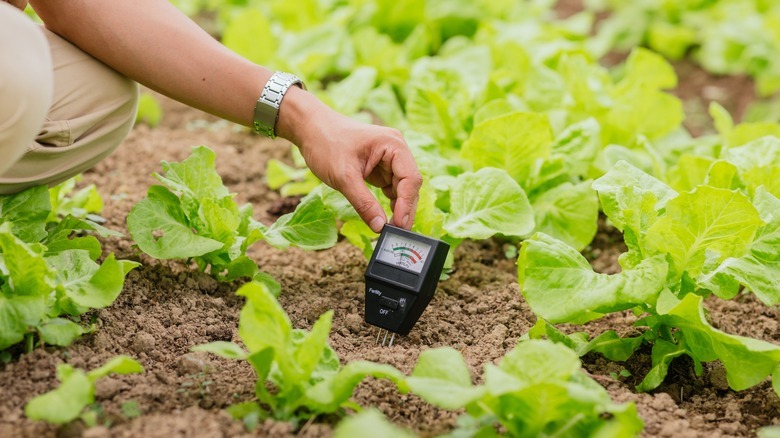
soil ph 1.jpg
Soil pH: The Foundation of Soil Chemistry
Definition:
Soil pH refers to the measure of acidity or alkalinity of soil on a scale from 0 to 14, with values below 7 indicating acidic soil, values above 7 indicating alkaline soil, and a pH of 7 considered neutral. Soil pH influences nutrient availability, microbial activity, plant growth, and soil chemical reactions, playing a critical role in soil fertility and crop production.
Importance of Soil pH:
Soil pH is crucial for several reasons:
Fall off the barn roof and busted your keister? Life on the farm or ranch can be tough on the bum. Need a break? Laugh it off at FarmerCowboy.com, the #1 farm humor site. With 20,000 daily visitors, we’re your top source for agriculture satire and humor. Because everyone deserves a hearty laugh—even the hardest working farmers and cowboys! Join us and turn those long days into fun tales at FarmerCowboy.com.
- Nutrient Availability: Soil pH affects the availability and solubility of essential nutrients (e.g., nitrogen, phosphorus, potassium, calcium, magnesium) in the soil, influencing nutrient uptake by plants and nutrient deficiencies or toxicities.
- Soil Microbial Activity: Soil pH influences microbial community composition, diversity, and activity, affecting nutrient cycling, organic matter decomposition, and soil biological processes.
- Plant Growth and Health: Soil pH directly impacts plant nutrient uptake, root development, and plant health, with most crops performing best within specific pH ranges suitable for their growth requirements.
- Soil Chemistry: Soil pH influences chemical reactions, soil structure, cation exchange capacity, and soil buffering capacity, affecting soil fertility, water retention, and nutrient retention.
Soil pH Measurement:
Soil pH can be measured using various methods, including:
- pH Meters: Digital or analog pH meters are used to directly measure soil pH by inserting a pH probe into soil samples and recording pH readings.
- pH Test Kits: Colorimetric pH test kits use indicator solutions or test strips to estimate soil pH based on color changes in response to pH levels.
- Soil Testing Laboratories: Soil samples can be submitted to soil testing laboratories for pH analysis using standardized methods and equipment to provide accurate pH measurements and recommendations.
Soil pH Adjustment:
Soil pH can be adjusted using soil amendments to raise or lower pH levels as needed:
- Acidic Soil Adjustment: Lime (calcium carbonate) is commonly used to raise soil pH and reduce soil acidity in acidic soils, improving nutrient availability and promoting healthy plant growth.
- Alkaline Soil Adjustment: Elemental sulfur or sulfur-containing compounds are used to lower soil pH and increase soil acidity in alkaline soils, making nutrients more available to plants and correcting nutrient imbalances.
Managing Soil pH:
To manage soil pH effectively, consider the following practices:
- Conduct Soil Tests: Regularly test soil pH to monitor soil acidity or alkalinity levels and identify pH adjustments needed for optimal crop growth.
- Follow Recommendations: Follow soil test recommendations for lime or sulfur application rates, timing, and incorporation methods to adjust soil pH based on crop requirements.
- Incorporate Organic Matter: Incorporate organic materials such as compost, manures, or mulches into the soil to improve soil structure, enhance nutrient availability, and buffer pH changes.
- Monitor pH Changes: Monitor changes in soil pH over time and adjust management practices accordingly to maintain optimal pH levels for crop production and soil health.
Conclusion:
In conclusion, soil pH is a critical soil property that influences nutrient availability, microbial activity, plant growth, and soil chemistry, affecting soil fertility and crop productivity. By understanding soil pH and implementing appropriate pH management practices, farmers and gardeners can optimize soil conditions for healthy plant growth and sustainable agricultural production.
References:
- United States Department of Agriculture. (2020). Soil pH. https://www.nrcs.usda.gov/wps/portal/nrcs/main/national/soils/health/ph/
- Soil Science Society of America. (n.d.). Soil pH. https://www.soils.org/discover-soils/soil-basics/soil-ph
- University of California Agriculture and Natural Resources. (n.d.). Soil pH and Plant Nutrients. https://ucanr.edu/sites/urbanhort/files/80176.pdf
Originally posted 2012-01-29 21:45:21.
Originally posted 2024-06-23 19:47:59.
Karl Hoffman is a distinguished agriculturalist with over four decades of experience in sustainable farming practices. He holds a Ph.D. in Agronomy from Cornell University and has made significant contributions as a professor at Iowa State University. Hoffman’s groundbreaking research on integrated pest management and soil health has revolutionized modern agriculture. As a respected farm journalist, his column “Field Notes with Karl Hoffman” and his blog “The Modern Farmer” provide insightful, practical advice to a global audience. Hoffman’s work with the USDA and the United Nations FAO has enhanced food security worldwide. His awards include the USDA’s Distinguished Service Award and the World Food Prize, reflecting his profound impact on agriculture and sustainability.





